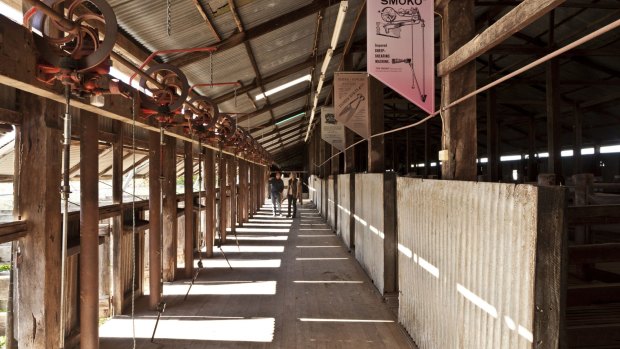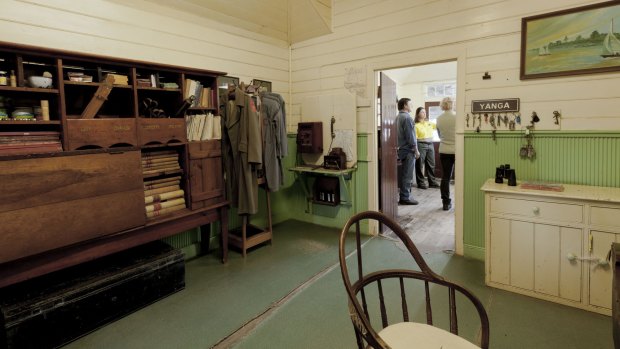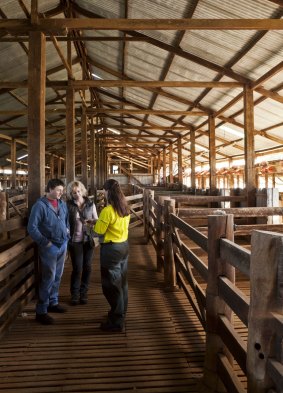This was published 7 years ago
Yanga National Park, Australia: Stuck in a time capsule at Yanga Station

Yanga Homestead is one of the nation's most striking time capsules.Credit: OEH/D Finnegan
The walk through the pens is considerably less terrifying than it would be for the sheep, and considerably quieter than it was a decade ago.
The shears stopped clicking at the Yanga Woolshed in 2005. Now all that's left inside this phenomenally atmospheric behemoth of a building are the ghosts of the pastoral past. More than 10 years on, the sheep smell is vigorously obtrusive and lanolin stains besmirch the walls. But where once this 100-metre-plus high temple of Australia's wool industry would be screaming with the noise of 3000 unhappy sheep and order-barking shearers, now there's just the wind rattling the corrugated iron flaps that fill the gaps between the river red gum beams.
Yanga Station was once the biggest freehold pastoral property in the country. Now it is one of NSW's newest National Parks. And for all the talk of preserving wetlands, river red gum forests and endangered frogs, it is the furiously evocative relics of what once was that make the Yanga National Park distinctive.

Yanga woolshed.Credit: OEH/D Finnegan
The homestead is a few kilometres further down the Sturt Highway from the woolshed – it was easier to get the sheep to walk their own fleeces down to the Murrumbidgee River for the waiting paddlesteamers than truck them by road once sheared.
It's a place, initially at least, best approached alone. That way, there's no-one to dilute that sense of stumbling across an abandoned ruin. Wisps of history swirl around in the wind, and gingerly snooping inside the iron-clad buildings feels both satisfyingly voyeuristic and something a doomed idiot would do in a horror film.
The smithy still has charcoal chunks and hunks of metal on the floor. The only animals in the stables are ants. The rusting netposts and forlorn, frayed net of the tennis court – once the centre of the station's social life – are left to nature's whims.

Yanga Homestead Bookkeepers office.Credit: OEH/D Finnegan
Perished tractors, tyres long flat, stand guard. The old store sits teetering on its minor clifftop, slowly losing its battle against the elements and gravity.
It takes the cook's cottage to break the spell. Inside, there's a surprisingly high tech exploration of the station's past. And the "Manager's Tour" ventures inside the main building. Here, the dining room table is left set as it would have been had guests come round. The bookkeeper's office brims with detail – a gorgeous old switchboard phone apparently installed by the nephew of Alexander Graham Bell, little bottles of poison left on the shelves, pigeonholes labelled "peacocks" and "rabbiters".
The neighbouring manager's office is frozen in time too. The calendars still say 2005, the then-modern computer looks clunkily old, documents remain filed under "permits to travel stock" and "permits to light fires".

Yanga woolshed.Credit: OEH/D Finnegan
When the Black family sold the property to National Parks in 2005, they were based in England and had little sentimental attachment to the furniture. So it was sold as-is. And has been kept that way in what will eventually prove to be a most remarkable time capsule.
One thing that has changed is Yanga Lake. It was originally what made the property so attractive, allowing vast hectares of the surrounding saltbush plain to be grazed. But in 2005, it had basically died a bleak, waterless death. The lake bed was used for cropping, in order to take advantage of the residual moisture while all else around was bone dry through drought. Then in 2010, the floods came. Now the lake – shaped like twin lungs around two jutting promontories to the north and south – is healthily full, and ripe for a spot of birdwatching by kayak.
The National Parks office just next to the homestead rents kayaks out as part of the transition from wool industry to tourism industry. They're pushed off from the recently resurrected shore, with hovering egrets keeping a close eye on this unusually-shaped interloper.
Pelicans do what pelicans do best – comically ungainly beak opening, followed by graceful glides across the water, clownishly clumsy take-offs and elegantly effortless flight.
And, by the water's edge, the thin silvery-grey trunks of young river red gums grow. They're accompanied by the occasional bigger, more gnarled and twisted grotesque – only the ones thought to make terrible timber survived being chopped down. But as the lake as come back, now so will the forest. Now the lambs have been silenced, the land can return to its former glory.
TRIP NOTES
MORE INFORMATION
visitnsw.com
nationalparks.nsw.gov.au
GETTING THERE
Yanga National Park is near Balranald, a 430km drive from Melbourne and 838km from Sydney. It's a logical stop on a Sydney to Adelaide road trip. The nearest airport with scheduled flights is in Mildura, 169km away with flighte from Sydney and Melbourne operated by Regional Express; see rex.com.au.
STAYING THERE
Lake Paika Accommodation is about 20 minutes' drive north of Balranald. Simple, rustic twin or double rooms with swoony sunset views, from $120 a night; see lakepaikaaccommodation.com.au.
SEE + DO
The 'Manager's Tour' of the Yanga Homestead lasts around 90 minutes, includes morning tea, runs at 10.30am on weekdays and costs $20. Kayak hire costs $40 per half day.
David Whitley was a guest of Destination New South Wales.
Sign up for the Traveller Deals newsletter
Get exclusive travel deals delivered straight to your inbox. Sign up now.